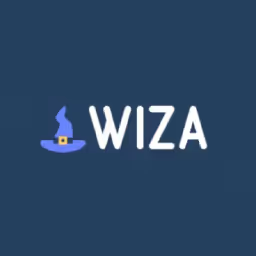Orum Alternatives
Find your Orum alternative. We compare 10 top sales dialers, analyzing features, pricing, and differences to help you choose the right tool.

You might be using Orum for its strong points. The platform excels at boosting call efficiency with its parallel dialer, helping sales teams save time and connect with more prospects. It's a solid choice for increasing conversation volume and getting more at-bats.
But like any tool, it has limits. Some users note occasional call issues, software bugs, or dialer limitations. That's why we've analyzed the best alternatives based on G2 reviews to help you find the right fit for your team. Let's get started.
Consider 11x for Digital Sales Workers
For teams interested in adding digital workers to their sales process, 11x is a platform to consider. It provides autonomous agents designed to handle specific sales tasks, allowing your representatives to focus elsewhere.
At 11x, we use AI agents to manage your sales process. Our agent, Alice, finds prospects and handles outreach, while Julian qualifies leads and books meetings. Our platform combines data enrichment, outreach, and email warmup tools into one.
Orum Alternatives
Below is a detailed breakdown of each Orum alternative. We analyze pricing, core features, and the main benefits and potential downsides when compared directly to Orum.
1) ConnectAndSell

ConnectAndSell uses human agents and AI to connect sales reps directly with decision-makers. The platform gets past gatekeepers and phone trees to start live conversations. It helps teams generate qualified meetings and reach C-level or VP-level prospects.
The service also offers phone number enrichment, real-time coaching, and structured talk tracks. These features support reps to improve performance and attribute revenue to specific outbound call efforts.
ConnectAndSell's Main Features
- The platform provides two dialing modes: Express Connect routes reps to the first live voice, while Precision Connect uses human agents to reach specific decision-makers.
- An AI agent suite enriches phone numbers, prioritizes outreach based on intent signals, and scores conversations to highlight coaching opportunities.
- The service includes live coaching for managers to guide reps during calls and a hands-on training program called Flight School to help master first conversations.
How ConnectAndSell Compares to Orum
Average Review score: 4.3/5 stars based on 227 G2 reviews.
- ConnectAndSell uses human agents to get past gatekeepers, which is different from Orum's technology-only approach to dialing.
- The platform has a "Precision Connect" mode that uses agents to reach specific people. This offers more targeting than Orum's system, which connects to the first available person.
- It includes a live coaching feature for managers to help reps during active calls. Orum's tools, in contrast, are generally for analysis after the call ends.
- A teleprompter feature provides reps with on-screen scripts during conversations. This gives more direct support within a call than Orum's platform.
Potential Downsides Compared to Orum
- ConnectAndSell does not provide a parallel dialing function like Orum. It relies on human agents for connections, which sometimes creates a short pause before the sales rep joins the live call.
- The use of human agents can make the service more expensive than purely software-based dialers such as Orum.
- Some users report that the tool has integration issues with their CRM. This can complicate the process of syncing call data compared to other platforms.
- The system's performance depends on human agents. This is different from Orum's technology-only approach and might affect connection consistency during peak hours.
Cost Comparison and Budget Impact
Neither Orum nor ConnectAndSell provides public pricing details, but user reviews indicate both are premium-priced tools. Based on that data, Orum may offer a faster return on investment at six months, compared to nine for ConnectAndSell. Orum users also report a higher average discount.
2) PhoneBurner

PhoneBurner is a sales platform for high-volume outreach. Its Power Dialer helps reps place calls up to 4x faster, without the pause found in many auto-dialers. It uses ARMOR® technology to prevent spam flags and runs on a Tier-1 network to help increase connection rates.
The platform also combines voice with email and SMS, automates post-call tasks, and includes reporting and coaching tools.
PhoneBurner's Main Features
- The Power Dialer enables delay-free dialing and blends voice with email and SMS.
- Its ARMOR® technology offers real-time spam-flag detection, remediation, and number rotation to improve answer rates.
- A cadence builder creates repeatable, multi-step follow-up sequences.
- The platform includes a built-in CRM to manage contacts, segment lists, and launch call campaigns.
How PhoneBurner Compares to Orum
Average Review score: 4.7/5 stars based on 260 G2 reviews.
- PhoneBurner uses a power dialer that provides instant, delay-free connections. This is different from Orum's parallel dialing, which can sometimes have a slight pause before connecting the rep.
- It includes ARMOR® technology to monitor and prevent numbers from being flagged as spam. This feature helps increase answer rates, a different approach to call deliverability compared to Orum.
- The platform combines calls with email and SMS outreach in one place. Orum, in comparison, focuses more specifically on call automation.
- User data suggests PhoneBurner may provide a faster return on investment at five months. This is slightly quicker than the six-month average reported for Orum.
- This tool offers live coaching, allowing managers to assist reps during active calls. Orum's coaching features are generally used for analysis after a call is complete.
Potential Downsides Compared to Orum
- PhoneBurner uses a power dialer that calls numbers one by one. This may result in a lower total call volume compared to Orum’s parallel dialer, which contacts multiple prospects at once.
- The platform does not offer some of the advanced AI features found in Orum, such as automated call summaries or detailed conversation analysis after a call ends.
- Some users report occasional limitations with CRM integrations. This can sometimes complicate data syncing for specific workflows compared to Orum's system.
Cost Comparison and Budget Impact
PhoneBurner offers transparent pricing, with its Standard plan starting at $125 per user per month when billed annually. In contrast, Orum does not provide public pricing details, but user reviews indicate it is a premium-priced tool. For teams needing predictable budgeting, PhoneBurner’s clear pricing is an advantage, while Orum may require direct contact for a custom quote.
3) Aircall
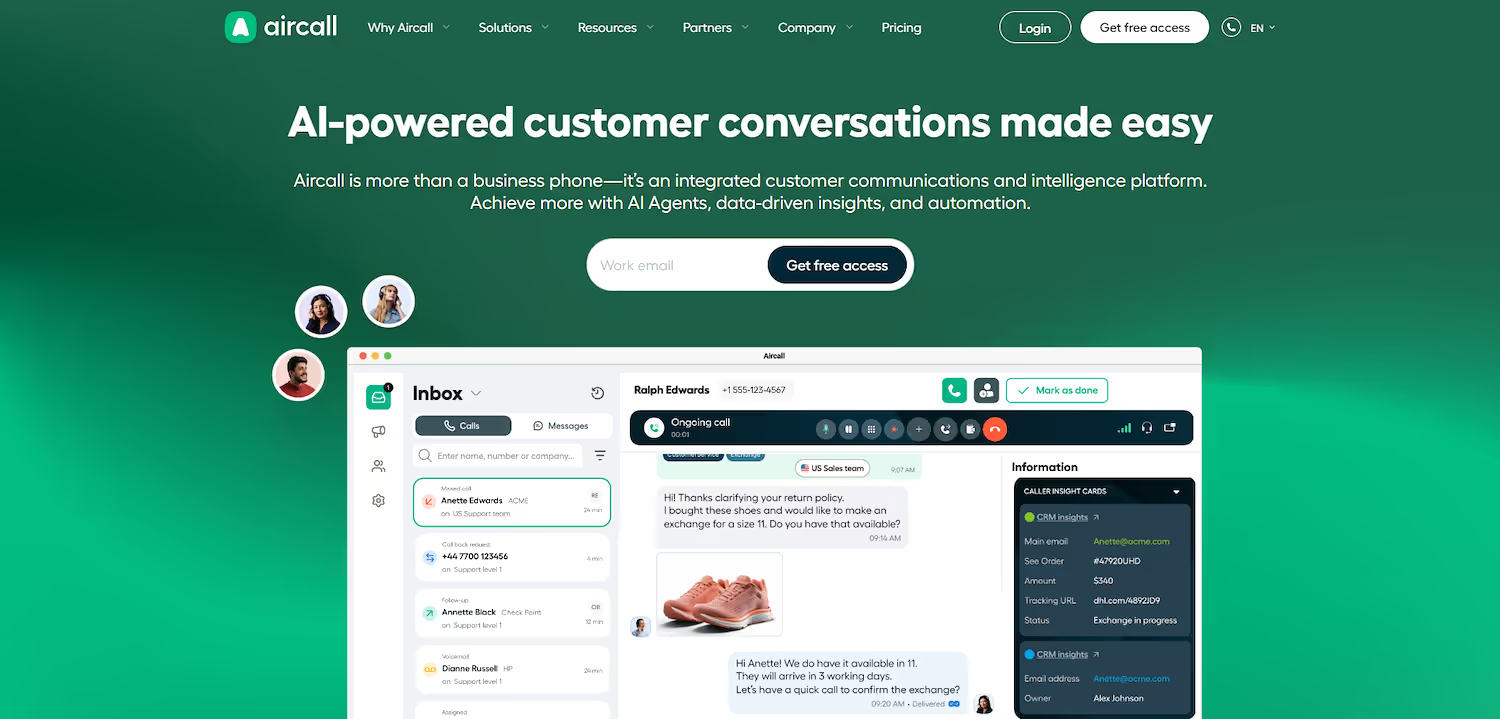
Aircall is a cloud communications platform for sales and support teams. It combines voice, SMS, and WhatsApp into one workspace. The system includes a Power Dialer for outbound sales and AI agents to handle inbound calls. It works without hardware via desktop and mobile apps.
The platform provides real-time coaching and analytics, with over 100 native integrations to tools like Salesforce and HubSpot.
Aircall's Main Features
- An AI voice agent handles, qualifies, and routes inbound calls 24/7.
- The platform provides a unified workspace to manage calls, SMS, and WhatsApp conversations.
- AI Assist offers real-time coaching for reps during live calls and automates follow-up workflows.
- The service includes over 100 native integrations with platforms like Salesforce, Zendesk, and Shopify.
How Aircall Compares to Orum
Average Review score: 4.4/5 stars based on 1,314 G2 reviews.
- Aircall combines voice, SMS, and WhatsApp into a single workspace. This provides more communication channels than Orum, which focuses mainly on call automation.
- It offers an AI voice agent to handle and route inbound calls. This differs from Orum's system, which is designed for outbound sales dialing.
- The platform provides over 100 native integrations with tools like Salesforce and HubSpot. This offers a wider range of connectivity options compared to Orum's integration capabilities.
- This tool includes a mobile app for making calls on the go. This gives more flexibility than Orum, which is primarily a desktop-based platform.
Potential Downsides Compared to Orum
- Aircall uses a power dialer that calls one number at a time. This approach may result in lower outbound call volume compared to Orum’s parallel dialer, which contacts multiple prospects at once.
- The platform’s AI capabilities focus primarily on inbound call routing. This is different from Orum, which uses AI to screen for voicemails and bad numbers during outbound campaigns, connecting reps only to live answers.
- Some user reviews mention that call quality can depend on internet stability, which might lead to occasional connection issues. Orum's system is built specifically to maximize stable, live conversations for outbound teams.
Cost Comparison and Budget Impact
Aircall offers transparent pricing, with plans starting at $30 per user per month, making it a good option for teams that need predictable costs. In contrast, Orum does not publish its pricing and requires a custom quote, which may better suit organizations needing a tailored package. For the most accurate pricing information, check the details on Aircall's official website.
4) Kixie
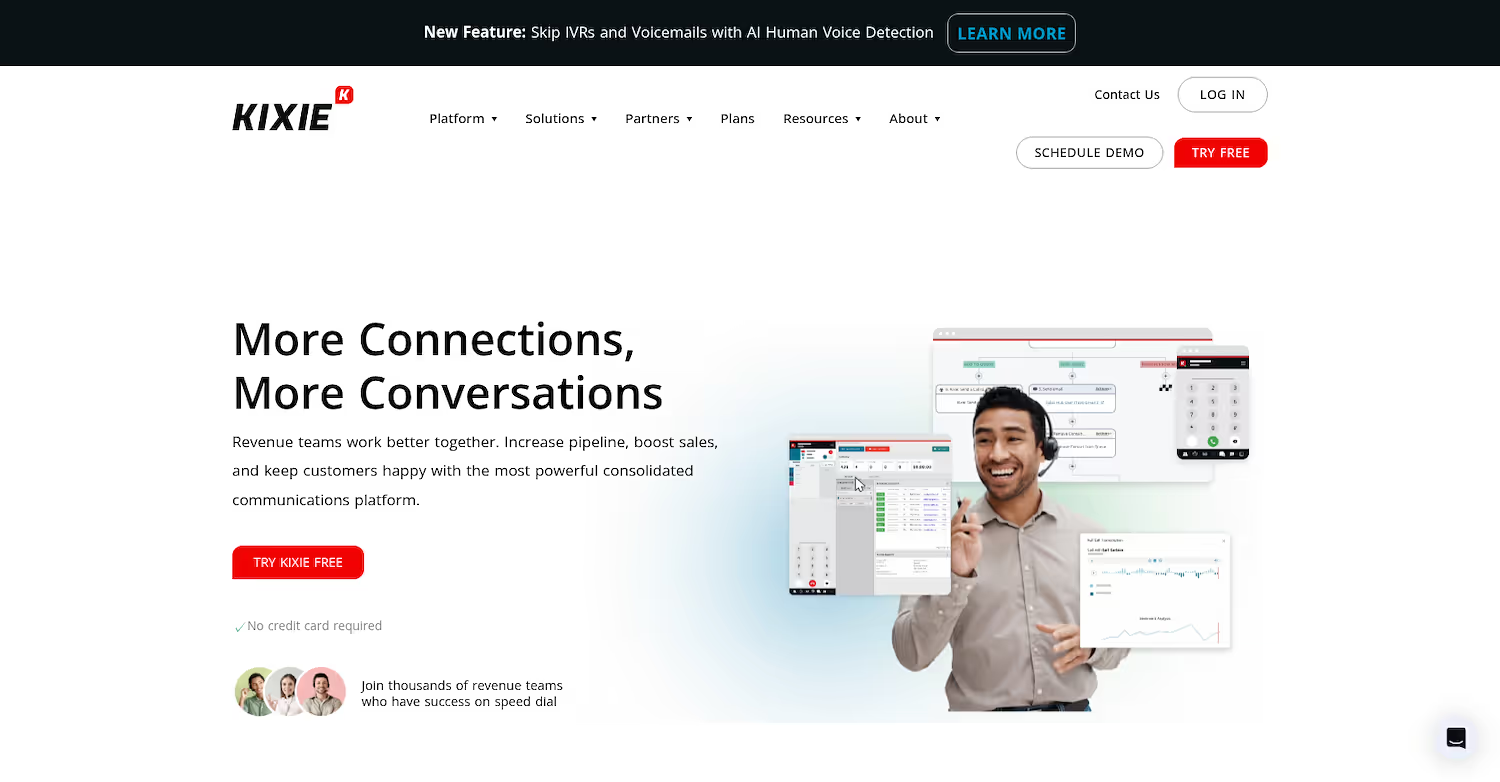
Kixie is a sales engagement platform that combines voice, SMS, and email outreach. It provides a power dialer and a multi-line dialer to automate calls. The system integrates with CRMs to support sales workflows and connect with prospects.
The platform is for sales teams that need to place outbound calls and set appointments. It also includes tools for managers to coach agents and review performance data.
Kixie's Main Features
- A multi-line power dialer contacts up to 10 leads at the same time and includes built-in machine detection to screen calls.
- The ConnectionBoost feature uses AI-powered local-presence dialing with progressive Caller ID to help prevent calls from being marked as spam.
- The platform provides team SMS with shared inboxes and internal notes for collaborative responses.
- A conversation intelligence tool tracks keywords, analyzes sentiment, and generates AI call summaries that sync to the CRM.
How Kixie Compares to Orum
Average Review score: 4.8/5 stars based on 830 G2 reviews.
- Kixie uses AI-powered local presence dialing to show a local number to prospects, which can improve answer rates. This is a different approach to call deliverability than Orum's system.
- The platform combines voice with team SMS capabilities, including shared inboxes. This offers a multi-channel approach, unlike Orum's primary focus on voice call automation.
- It also manages inbound calls with features like CRM-based routing to direct callers to the correct representative. Orum, in contrast, is built mainly for outbound sales campaigns.
- A conversation intelligence feature tracks keywords and analyzes sentiment from calls. This provides specific data points for coaching that differ from the broader call analysis tools in Orum.
Potential Downsides Compared to Orum
- Kixie combines voice, SMS, and email into one platform. In comparison, Orum focuses only on parallel dialing, which provides a more streamlined tool for teams whose main goal is maximizing live conversations.
- Some users mention an initial learning curve because of the platform's wide range of features. Orum's interface, built solely for dialing, can sometimes be easier for sales teams to adopt quickly.
- User data suggests the platform has an average return on investment of eight months. This is slightly longer than the six-month ROI period reported for Orum, which can be a factor for teams that need faster results.
Cost Comparison and Budget Impact
Like Orum, Kixie does not provide public pricing, and models can vary significantly. For the most accurate and up-to-date pricing information, we recommend visiting Kixie's official website.
5) JustCall
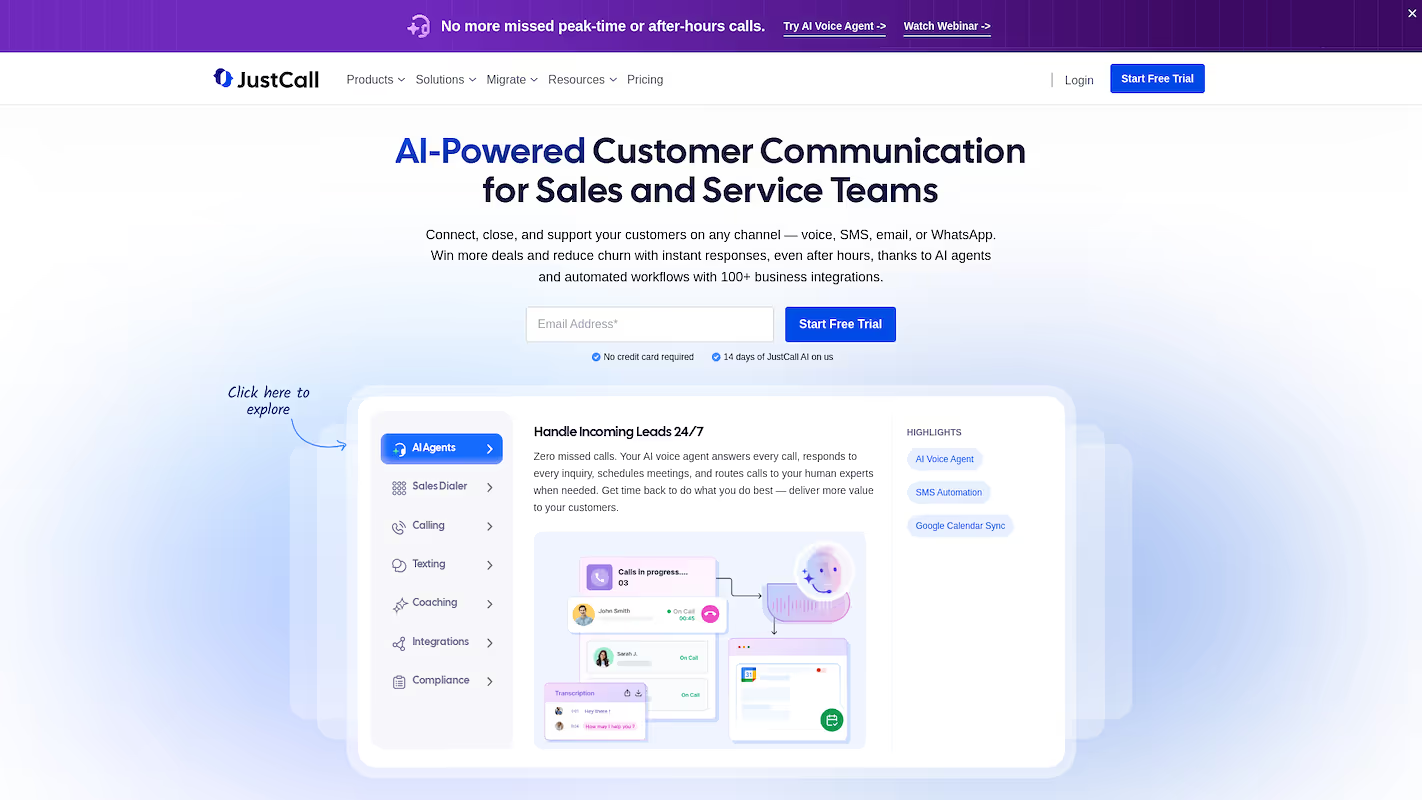
JustCall is a communication platform that uses AI for sales and support teams. It combines voice, SMS, and WhatsApp tools. The system includes a power dialer and a predictive dialer to automate outreach.
It also offers conversation intelligence to coach agents and features to schedule appointments. The platform integrates with many CRMs to centralize data.
JustCall's Main Features
- Offers multiple dialer types, including predictive, power, and a multi-line option that dials up to 10 numbers at once.
- An AI voice agent acts as a 24/7 receptionist to handle inquiries, book meetings, and route calls.
- The platform includes a unified messaging suite for SMS, MMS, and WhatsApp with bulk campaign capabilities.
- Conversation intelligence provides real-time agent assistance, live objection handling suggestions, and automatic call summaries.
How JustCall Compares to Orum
Average Review score: 4.3/5 stars based on 2,210 G2 reviews.
- JustCall provides an AI voice agent for inbound calls to book meetings and route inquiries. This is different from Orum, which uses its AI primarily for outbound call screening.
- The platform combines voice with SMS and WhatsApp messaging. This offers more communication channels than Orum, which centers on voice calls.
- It offers real-time agent assistance during live calls, with suggestions to handle objections. Orum's coaching tools are generally for post-call analysis.
- This tool includes several dialer modes, such as predictive and power dialing. This gives teams more options compared to Orum's parallel-only dialing system.
Potential Downsides Compared to Orum
- Orum’s AI focuses only on screening out voicemails to connect reps to live answers. Since JustCall's AI also manages inbound calls, its outbound filtering can feel less specialized for teams that need maximum dialing efficiency.
- The platform combines voice, SMS, and WhatsApp. For teams that only need to maximize live outbound calls, this all-in-one approach can introduce complexity compared to Orum's singular focus on parallel dialing.
- Some users report occasional issues with call quality or dropped connections. This can be a concern for sales teams where call stability is a top priority, an area where Orum's infrastructure is highly focused.
Cost Comparison and Budget Impact
JustCall offers transparent pricing, with its Team plan starting at $29 per month for two users when billed annually. Orum does not provide public pricing and requires a custom quote. For the most accurate pricing information, we recommend visiting JustCall's official website.
Add Digital Workers With 11x
If your team wants to add digital workers to its sales process, 11x provides autonomous agents. They handle tasks like prospecting and outreach, which allows your representatives to focus on other priorities. See how 11x can support your sales efforts.
At 11x, we use AI to manage your sales process. Our agent Alice finds prospects and handles outreach, while Julian qualifies leads and books meetings. Our platform combines data, outreach, and email warmup tools into one, replacing several parts of a GTM stack.
Book a demo to see how it works.
6) Dialpad Ai Sales
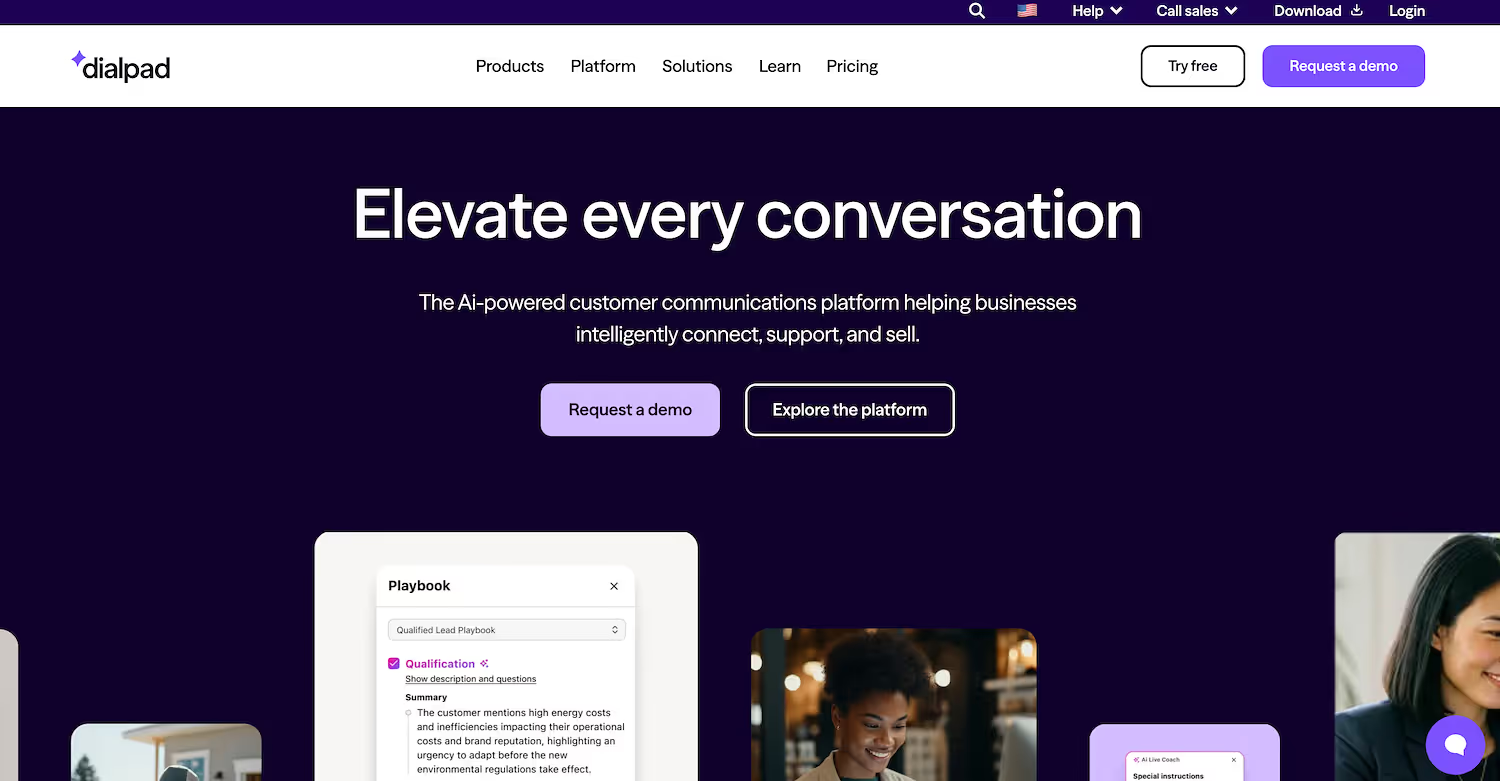
Dialpad Ai Sales is a communication platform with an AI-powered sales dialer. It includes power and predictive dialer modes to contact multiple numbers at once. The system integrates with CRMs to connect sales workflows.
The platform supports sales training through real-time coaching, AI scorecards, and post-call analytics. This live assistance and data analysis helps reps improve performance.
Dialpad Ai Sales's Main Features
- Delivers real-time prompts, competitor battle cards, and objection-handling tips in the call window.
- Tracks whether reps follow required talk tracks using pre-built or custom AI playbooks and scorecards.
- Provides real-time transcription and voice analytics, including sentiment analysis and keyword tracking.
- Offers access through desktop, mobile, and a Chrome extension for voice, video, and messaging.
How Dialpad Ai Sales Compares To Orum
Average Review score: 4.4/5 stars based on 4,351 G2 reviews.
- Dialpad Ai Sales provides real-time coaching with on-screen prompts during live calls. This is different from Orum, where coaching tools are mainly for post-call analysis.
- The platform combines voice, video, and messaging in one workspace. This offers more communication channels compared to Orum, which centers on voice call automation.
- A mobile app allows reps to make calls on the go. This provides more flexibility than Orum, which is primarily a desktop-based platform.
- Its AI playbooks track whether reps follow required talk tracks in real time. This offers a different type of performance monitoring compared to the general call analysis in Orum.
Potential Downsides Compared To Orum
- Dialpad provides power and predictive dialer modes. This approach may result in fewer live conversations compared to Orum's parallel system, which contacts multiple numbers at once to maximize connections.
- The platform is an all-in-one communication tool with voice, video, and messaging. For teams that only need a dedicated solution for outbound calls, this broad feature set might be more complex than Orum's specialized focus.
- Its AI assists with real-time coaching and analysis. This differs from Orum's AI, which screens out voicemails and bad numbers to directly increase the number of live prospects a rep speaks to.
Cost Comparison and Budget Impact
Neither Dialpad Ai Sales nor Orum provides public pricing details. User data indicates Orum may offer a faster return on investment at six months, compared to 12 months for Dialpad. For the most accurate pricing information, we recommend visiting the Dialpad Ai Sales's official website.
7) Salesloft
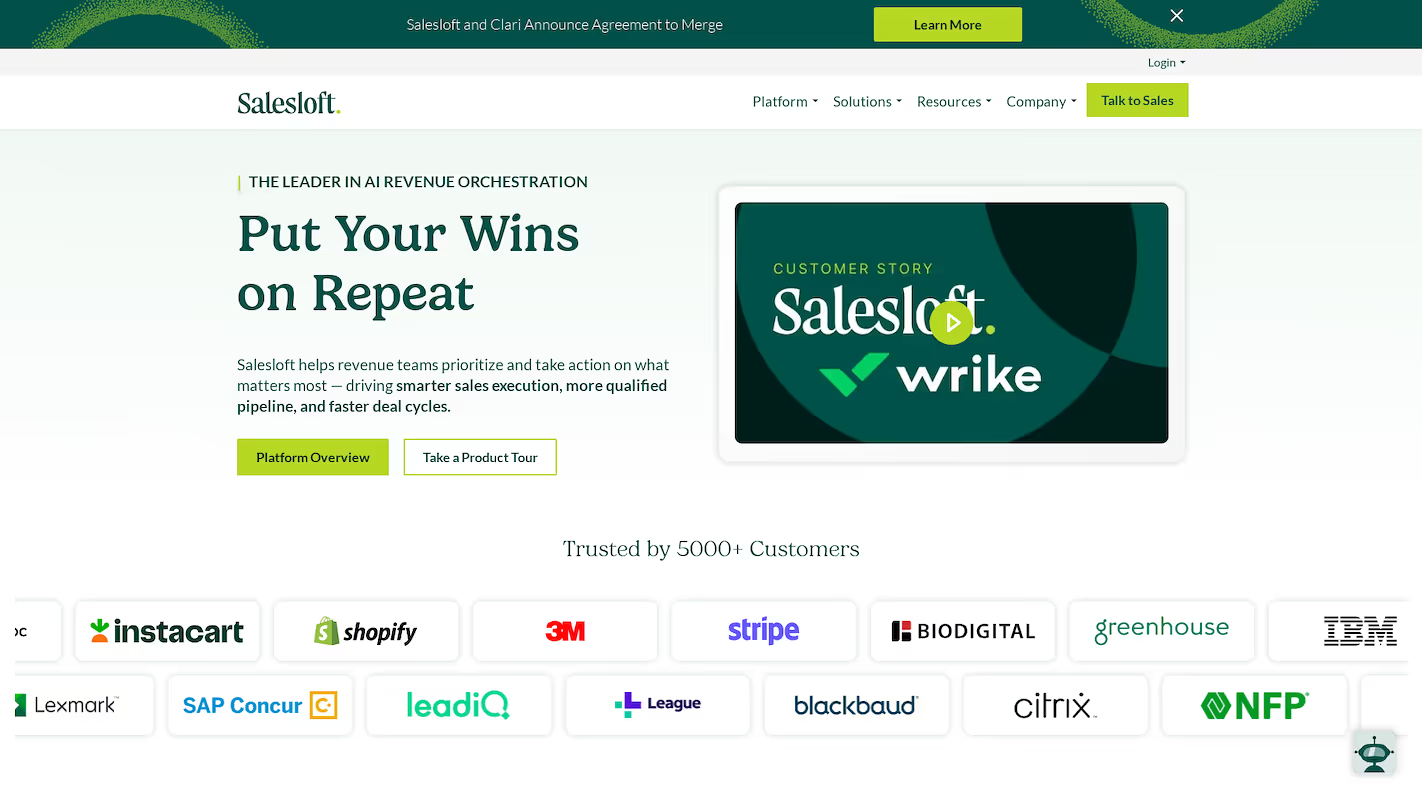
Salesloft is a sales engagement platform that gives revenue teams a structure for their sales process. It helps organize outreach with cadences for calls and emails, and provides a dialer to connect with prospects.
The system also includes conversation intelligence and analytics. This data supports sales training and helps leaders understand team performance.
Salesloft's Main Features
- Automates pipeline building, lead nurturing, and renewals through structured workflows called Cadences.
- Prioritizes sales actions using an AI engine called Rhythm that recommends the right steps at the right moments.
- Manages the deal pipeline with AI insights into risk, next steps, and velocity.
- Combines real-time deal data, AI, and seller input to create more accurate sales forecasts.
How Salesloft Compares to Orum
Average Review score: 4.5/5 stars based on 4,145 G2 reviews.
- Salesloft provides structured workflows called Cadences to guide outreach across multiple channels. This is different from Orum, which focuses on maximizing live call volume through its parallel dialer.
- Its AI engine, Rhythm, prioritizes a seller's daily tasks by recommending the next best action. This contrasts with Orum's AI, which is used to screen out voicemails during outbound call campaigns.
- The platform includes deal management and forecasting tools that use AI to analyze pipeline health. Orum is designed for top-of-funnel prospecting and does not offer these revenue intelligence features.
- Salesloft offers a full revenue orchestration platform that combines sales engagement with analytics. This provides a broader set of tools than Orum, which is a specialized solution for call automation.
Potential Downsides Compared To Orum
- Salesloft's dialer is part of a larger sales engagement system. It does not offer a parallel dialing function like Orum, which may result in fewer simultaneous calls and a lower volume of live conversations for teams focused on high-speed outreach.
- The platform's AI prioritizes sales tasks rather than screening calls. This is different from Orum's AI, which filters out voicemails to connect reps only to live answers, a feature some teams may find more direct for pure calling campaigns.
- User data suggests the time to see a return on investment is around 11 months. This can be a longer period compared to the six-month average reported for Orum, which might be a consideration for teams needing faster results.
Cost Comparison and Budget Impact
Neither Salesloft nor Orum provides public pricing details. User data indicates Orum may offer a faster return on investment at six months, compared to eleven months for Salesloft. For the most accurate pricing information, we recommend visiting Salesloft's official website.
8) Outreach
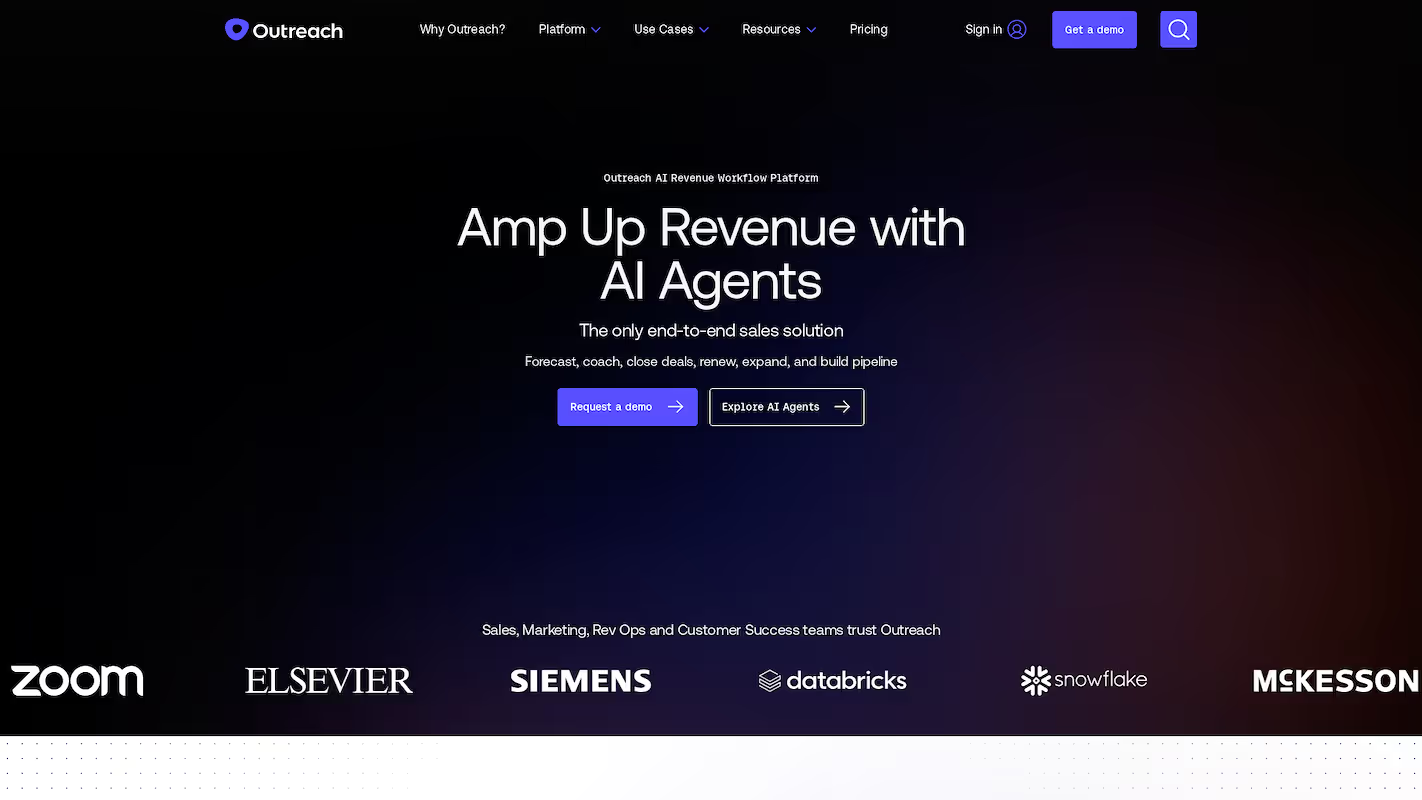
Outreach is a sales execution platform that helps revenue teams automate their process. It uses sequences to guide sellers through multichannel touchpoints, including calls and emails.
The platform provides a dialer for sales calls and tools to manage deals. It also offers analytics to track performance and forecast revenue, which supports sales training and strategy.
Outreach's Main Features
- The platform automates email campaigns and tracks engagement through analytics on open rates and link activity.
- It provides tools to personalize outreach for individual prospects.
- The system delivers a daily summary and other insights to guide sales strategy.
- It includes features for recording prospect data and managing contacts within the platform.
How Outreach Compares To Orum
Average Review score: 4.3/5 stars based on 3,479 G2 reviews.
- Outreach offers a full sales execution platform that includes deal management and forecasting. This is different from Orum, which is a specialized tool for call automation.
- The platform automates multichannel outreach with sequences for calls and emails. Orum, in contrast, centers its automation primarily on voice calls.
- Its AI provides insights for forecasting and deal management. This differs from Orum's AI, which focuses on screening calls to connect reps with live prospects.
- This tool provides analytics on email open rates and link activity. Orum's analytics are centered on call metrics and outcomes.
Potential Downsides Compared To Orum
- Outreach's dialer is designed to work within multi-step sequences. This approach may not generate the same high volume of live conversations as Orum's parallel dialer, which is built to maximize connections in a single session.
- The platform's AI offers predictive insights for deal health and forecasting. This differs from Orum's AI, which is used to detect and bypass voicemails, connecting reps only to live human answers during call campaigns.
- Teams may experience a longer time to see a return on investment, which user data places at 11 months. In comparison, Orum users report an average ROI period of six months, a factor for teams needing faster results.
Cost Comparison and Budget Impact
Neither Outreach nor Orum provides public pricing details. User data indicates Orum may offer a faster return on investment at six months, compared to eleven months for Outreach. For the most accurate pricing information, we recommend visiting Outreach's official website.
9) VanillaSoft

VanillaSoft is a sales engagement platform that gives inside sales teams a structured workflow. It helps prioritize and distribute leads to representatives. The platform includes a phone dialer to automate calls and tools to manage multi-step outreach for appointment setting.
VanillaSoft's Main Features
- The platform uses a queue-based system that automatically routes the next best lead to an available agent.
- Its lead prioritization logic organizes outreach based on prospect engagement levels and other custom rules.
- The system includes an automated voicemail drop, call recording, and an integrated calendar for scheduling callbacks.
How VanillaSoft Compares To Orum
Average Review score: 4.6/5 stars based on 545 G2 reviews.
- VanillaSoft uses a queue-based system to automatically route the next best lead to a sales rep. This is different from Orum, which dials a list of numbers in parallel to find any live connection.
- The platform includes lead prioritization logic to organize outreach based on engagement. This gives reps a structured workflow, while Orum's system is built to maximize call volume without this type of lead scoring.
- It offers an automated voicemail drop feature. This allows reps to leave pre-recorded messages, a function not available in Orum, which is designed to bypass voicemails and connect reps only to live answers.
- The tool has an integrated calendar for scheduling callbacks directly within the platform. This provides a more built-in scheduling function compared to Orum, which requires integration with other tools for appointment setting.
Potential Downsides Compared To Orum
- VanillaSoft uses a queue-based dialer that calls one lead at a time. This approach can result in a lower call volume compared to Orum’s parallel dialer, which contacts multiple prospects at once.
- The system routes leads but does not use AI to screen for voicemails. This is different from Orum, where AI filters non-live answers so reps only connect to humans.
- User data suggests an eight-month return on investment. This is slightly longer than the six-month period reported for Orum, which can be a factor for teams that need faster results.
Cost Comparison and Budget Impact
Neither VanillaSoft nor Orum provides public pricing details. User data suggests Orum may offer a faster return on investment at six months, compared to eight months for VanillaSoft. For the most accurate pricing information, we recommend visiting VanillaSoft's official website.
10) Mojo Dialer
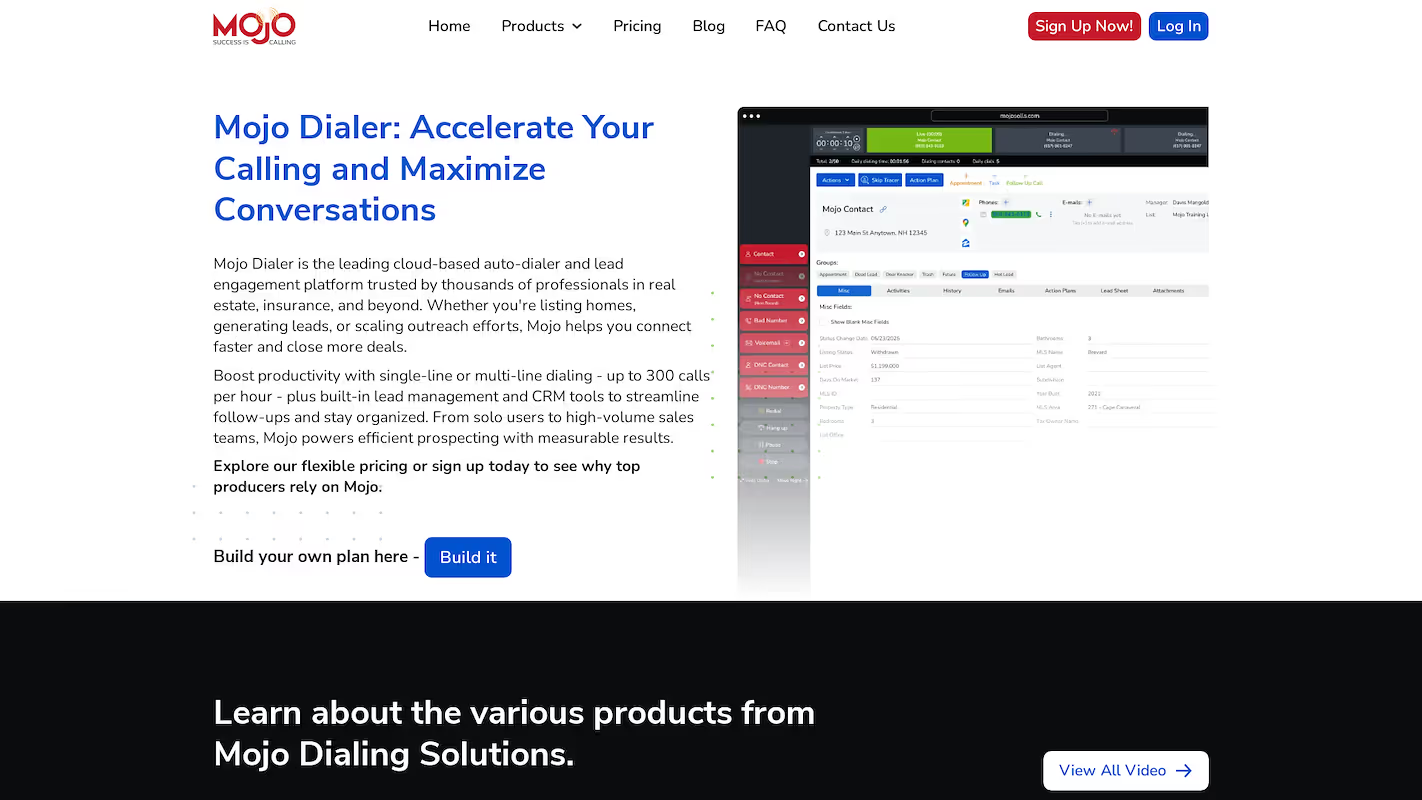
Mojo Dialer is a system for sales teams to prospect and contact leads. It provides a multi-line power dialer and lead management tools. The platform helps generate leads and set appointments. It also offers call record features for agent review and performance analysis.
Mojo Dialer's Main Features
- Offers progressive and preview dialing modes for outreach campaigns.
- Includes an Interactive Voice Response (IVR) system and voice activity detection.
- Provides call scrubbing to clean contact lists before dialing.
- Features callback scheduling and call recording for agent use.
How Mojo Dialer Compares To Orum
Average Review score: 4.0/5 stars based on 25 G2 reviews.
- Mojo Dialer offers preview and progressive dialing modes, which give reps more control over each call. This is different from Orum's parallel system that dials multiple numbers at once to maximize connection volume.
- The platform includes a call scrubbing feature to clean contact lists before a campaign starts. This is a different approach to list management compared to Orum, which uses AI to filter out bad numbers in real time.
- It provides an Interactive Voice Response (IVR) system to manage inbound calls. This adds a layer of inbound functionality that is not present in Orum, which focuses on outbound sales campaigns.
- This tool features built-in callback scheduling. This allows agents to manage follow-ups directly within the platform, while Orum typically requires integration with other tools for appointment setting.
- The service provides transparent pricing plans starting at $99 per license for a single user. This is different from Orum, which does not provide public pricing and requires a custom quote.
Potential Downsides Compared To Orum
- Mojo Dialer uses a multi-line system that calls up to three numbers at once. This approach may result in fewer live connections compared to Orum's parallel dialer, which contacts more prospects simultaneously to maximize conversation volume.
- The platform does not use AI to screen for voicemails before connecting a call. This is different from Orum's system, where AI filters out non-live answers so reps only speak with humans, which can increase efficiency.
- Some users report that the data quality can be inconsistent, which can lead to calls to non-working numbers. Orum's AI addresses this by filtering out bad numbers in real-time during a call session, which helps maintain dialing momentum.
Cost Comparison and Budget Impact
Mojo Dialer offers transparent pricing, with its single-user plan at $99 per license and the team triple-line dialer at $139 per license. In contrast, Orum does not provide public pricing and requires a custom quote. This makes Mojo Dialer a more predictable option for teams with fixed budgets, while Orum’s model may better suit organizations that need a tailored package.
Which One Should You Go With?
The right Orum alternative depends on many variables, from your team's sales process to budget. This guide analyzed several options to provide the data needed for an informed decision.
If your goal is to automate sales tasks with digital workers, 11x provides autonomous agents for prospecting and lead qualification. This approach allows your sales team to focus on closing deals instead of manual top-of-funnel activities.




